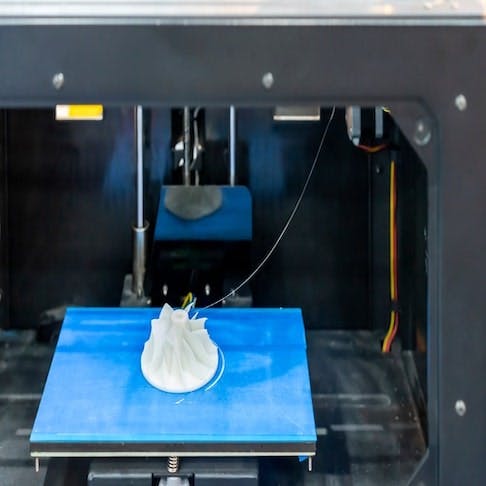
STL to STEP: How to Convert STL Files to STEP Files
Learn about these two file formats, how to perform a conversion, and the best tools to use.

STL to STEP: How to Convert STL Files to STEP Files
STL (STereo Lithography or Standard Triangle Language or Standard Tessellation Language) format is the “standard” file type used by the majority of 3D printers. It can communicate shape (without color or texture information) and is universally accepted and very reliable. STLs store the surface of an object as geometric data for a series of points. This generally results in triangular subsurfaces that describe the outward 3D shape. However, STL files do not give information about color, thickness, or texture.
STEP (or .STP or STandard for the Exchange of Product Model Data) is a widely used file type that fully represents 3D design data. It is viewed as the most reliably interoperable data transfer tool between CAD (Computer Aided Design) and CAM (Computer Assisted Manufacturing) systems. CAD and CAM systems use a wide range of proprietary and shared formats. They refer to these as their “native” file types. Therefore, a format that they can ALL share reliably and interpret accurately is a deeply valuable commodity.
When converting STL to STEP format for design or dimensional changes, several software tools are available to download or access online. Some are easier to use and more intuitive, like FreeCAD, which has the advantage that it easily creates solids that are higher quality than the original mesh file.
This article will discuss the STL to STEP file conversion, define STL, provide helpful tips on the best converter and programs to open them, as well as discuss the differences between STL and STEP.
1. Get a Conversion Tool
The easiest tool to use for STL to STEP file conversion is FreeCAD. Basic converters don’t do such a good job in general. This is because they generally convert as-is and don’t create a smoothed part but instead produce a solid with the flat mesh faces visible. The CAD capabilities of FreeCAD enable the user to progress immediately to make changes or just export as an .STP file.
4. Transform the Mesh Into a Shape
With the repaired mesh selected in the workspace, go to the Part command on the top menu and select “Create shape from mesh.” Set a sewing tolerance, which can be left at the default of 0.1—then click OK. In the combined view, you’ll now have two views—the mesh and the solid part you just created from it.
6. Export Your Solid Formation Into a STEP File
With the solid part selected in the workspace, click File >> Export and choose the STEP format from the options. Once complete, the file is ready for all uses. It is recommended to use Export instead of Save As. The “Save As” option will force the user to use a FreeCAD file format.
What Is an STL File?
An STL file is an ASCII format file that the company 3D Systems developed for their 3D printers. STL files have a low level of detail, as they contain no color or texture information and have a clunky file structure. In order to construct the triangles necessary to represent a 3D object, mesh information contains 3 points (x-y-z) of information for each triangular face. The “normal” is a line perpendicular to the triangle surface of 1 unit length, and its direction defines which planar face of the relevant triangle is the outward facing. While non-standard binary formats of STL have been developed, these are not commonly used.
What Programs Can Open STL Files?
Programs that can open STL files are CAD packages and specific .STL viewers. Examples are:
- Second Tier and Free CAD Applications: FreeCAD, Tinkercad, LibreCAD, ZBrush (formerly Sculptris), SketchUp, Fusion, FreeCAD, OnShape, and many more.
- Prime and Professional CAD Packages: SolidWorks, Catia, Creo (formerly ProE), AutoDesk, Siemens NX (formerly UniGraphics).
- Online Viewers: FilePro Info, 3D Usher, STP Viewer - ABViewer 15, ShareCAD, and more.
- Offline Viewers: Geomagic Verify Viewer, GOM Inspect, VariCAD Viewer, gCAD 3D, IDA-STEP, STP Viewer, EnSuite-View, NIST STEP File Analyzer/Viewer, and more.
What Is the Best STL to STEP File Converter?
The best STL to STEP file converters are:
- FreeCAD: FreeCAD is a lightweight CAD package with a wide range of capabilities and an easy-to-grasp user interface.
- Autodesk's Fusion: Autodesk Fusion offers a straightforward method of STL to STEP file conversion. It has three different methods of working with a mesh, including its Design Workspace, which is essentially the default workspace.
- GOM Inspect: This is another capable analysis and repair tool. It has many levels of function to explore that a regular user may find invaluable.
To learn more, see our STL File Converter guide.
How Long Does It Take To Convert an STL File to STEP?
STL to STEP file conversion can take up to a few seconds or more. The conversion time depends on the complexity of the file being converted.
What Are the Differences Between STL and STP Formats?
STL and STP are divergent formats with quite different intentions and purposes. Table 1 below illustrates the differences between the two:
| Capability | STL | STEP |
|---|---|---|
Capability Full surface geometry | STL Yes, with resolution compromises | STEP Yes |
Capability Full 3D geometry | STL No, outer surface data only | STEP Yes |
Capability Accuracy and resolution | STL Moderate to poor unless resolution and file size are high | STEP Excellent |
Capability Modification capability | STL Hard, requires conversion to STEP or another CAD format | STEP Easy |
Capability Faults that obstruct good printing | STL Can be common | STEP N/A |
Capability Interoperability | STL Universal among 3D printers | STEP Wide |
Summary
This article discussed the STL and STP file formats and how to convert an STL file to a STEP file. To learn more about STL to STEP file conversions and how you can use your files for a project, contact a Xometry representative.
Xometry provides a wide range of manufacturing capabilities, including 3D printing and other value-added services for all of your prototyping and production needs. Visit our website to learn more or to request a free, no-obligation quote.
Disclaimer
The content appearing on this webpage is for informational purposes only. Xometry makes no representation or warranty of any kind, be it expressed or implied, as to the accuracy, completeness, or validity of the information. Any performance parameters, geometric tolerances, specific design features, quality and types of materials, or processes should not be inferred to represent what will be delivered by third-party suppliers or manufacturers through Xometry’s network. Buyers seeking quotes for parts are responsible for defining the specific requirements for those parts. Please refer to our terms and conditions for more information.
